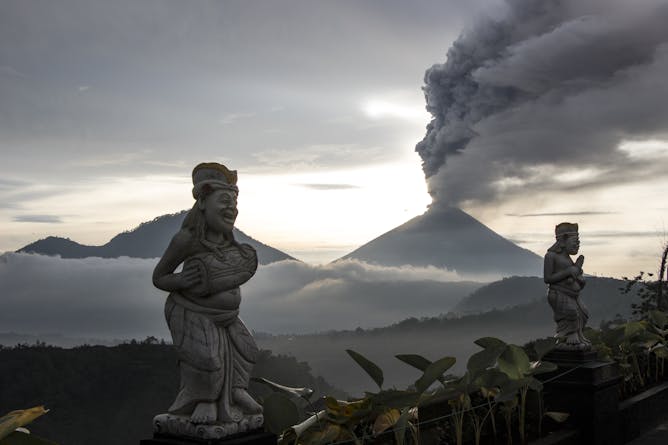|
For almost two weeks Mount Agung in Bali has been thrusting ash into the sky, and lava is visible at its peak. But experts still can’t be sure when it will erupt, despite close monitoring. As geologist Tracy Gregg explains, every volcano is different, and a sure-fire sign of eruption in one isn’t the same as another. Locals have been evacuated, and while this may save lives, it could also cause economic damage if no eruption happens.
And while Mount Agung narratives usually focus on tourists stranded in airports, the real significance is for the Balinese people and what an eruption would signify for them. As Graeme MacRae writes, most Balinese see these earth rumblings as a sign God is unhappy, and the last eruption in 1963 led to severe consequences for tourism, agriculture and livelihoods in its aftermath.
|

Mount Agung began erupting last week, sending ash columns two kilometres high.
AAP/NEWZULU/Kévin Bouvet
Graeme MacRae, Massey University
To the people of Bali, Mt Agung is not just a volcano. The "great mountain" holds spiritual power and reflects cultural and political unrest.
|
Arts + Culture
|
-
Anjali Monteiro, Tata Institute of Social Sciences; Jayasankar K. P., Tata Institute of Social Sciences
Passionate musicians in Western India are committed to “break down the walls” of hate built by opportunistic politics between religious communities.
|
|
Health + Medicine
|
-
Marina Joubert, Stellenbosch University
The unprecedented media interest in the first human heart transplant 50 years ago transformed many of the rules that governed the relationships between medicine and the media.
|
|
Politics + Society
|
-
Mia Swart, University of Johannesburg
It's still unclear whether Zimbabwe will manage an effective transition to participatory democracy and freedom. And the current signs are not encouraging.
-
Peter Vale, University of Johannesburg
The single greatest failure of current punditry is the refusal to recognise that context matters. A one-size-fits-all approach to solving Zimbabwe's complex set of problems simply won't help.
-
Ryan Brading, SOAS, University of London
By resorting to all means necessary, Nicolás Maduro's government has clawed its way back from the brink of collapse.
-
David McCallum, Victoria University
Schooling has historically been used to control Indigenous peoples, rather than to liberate or educate them.
|
|
Science + Technology
|
-
Tracy K.P. Gregg, University at Buffalo, The State University of New York
How do scientists predict volcanic eruptions? To do so with accuracy, they need to know the individual volcano and its history very well.
|
|